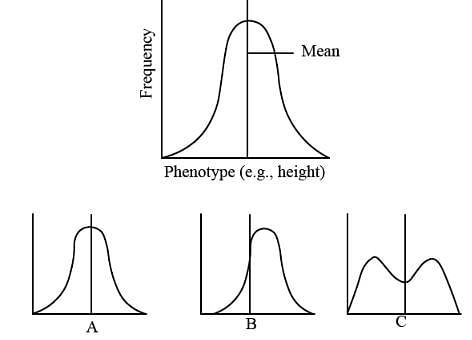Test: Mechanism of Evolution (NCERT) - NEET MCQ
15 Questions MCQ Test Biology Class 12 - Test: Mechanism of Evolution (NCERT)
Following is the diagrammatic representation of the operation of natural selection on different traits. Which among the following options correctly identifies all the three graphs A, B and C.




| 1 Crore+ students have signed up on EduRev. Have you? Download the App |
Replacement of the lighter-coloured variety of peppered moth (Biston betularia) to its darker variety (Biston carbonaria) in England is the example of
The Hardy-Weinberg principle cannot operate if
Read the following statements and choose the correct option.
(i) Increase in melanised moths after industrialisation in Great Britain is a proof for Natural Selection
(ii) When more individuals of a population acquire a mean character value, it is called disruption
(iii) Changes in allelic frequency in a population will lead to Hardy-Weinberg equilibrium
(iv) Genetic drift changes the existing gene or allelic frequency in future generations
An isolated population of humans with approximately equal numbers of blue-eyed and brown-eyed individuals was decimated by an earthquake. Only a few brown-eyed people remained to form the next generation. This kind of change in the gene pool is called a
Fill up the blanks in the following paragraph by selecting the correct option
When migration of a section of population to another place and population occurs, (i) change in the original as well as in the new population. New genes/alleles are added to the (ii) population and these are lost from the (iii) population. There would be a (iv) if this gene migration, happens multiple times. If the same change occurs by chance, it is called (v). Sometimes the change in allele frequency is so different in the new sample of population that they become a different species. The original drifted population becomes founders and the effect is called (vi).

Which of the following is most important for speciation?
At a particular locus, frequency of allele A is 0.6 and that of allele a is 0.4. What would be the frequency of heterozygotes in a random mating population at equilibrium?
Industrial melanism as oberved in peppered moth proves that
Match column I with column II and select the correct option from the given codes.

An inter-breeding population of finches became separated geographically, forming two isolated groups. Each group then became subject to different selective pressures. One group was then introduced into the habitat of the other. Which one of the following would determine whether they now formed two distinct species?
The factors involved in the formation of new species are
The different forms of interbreeding species that live in different geographical regions are called
|
87 videos|294 docs|185 tests
|












